TIBET HOUSE MAJOR EVENTS
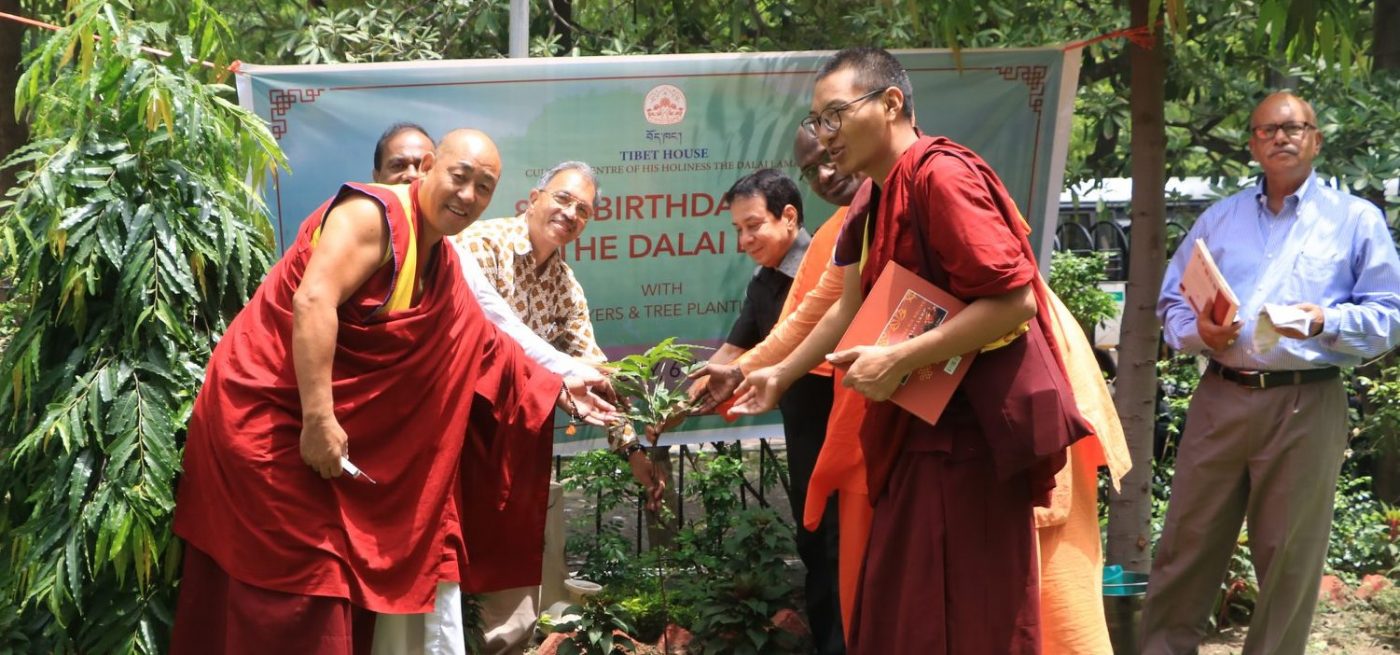
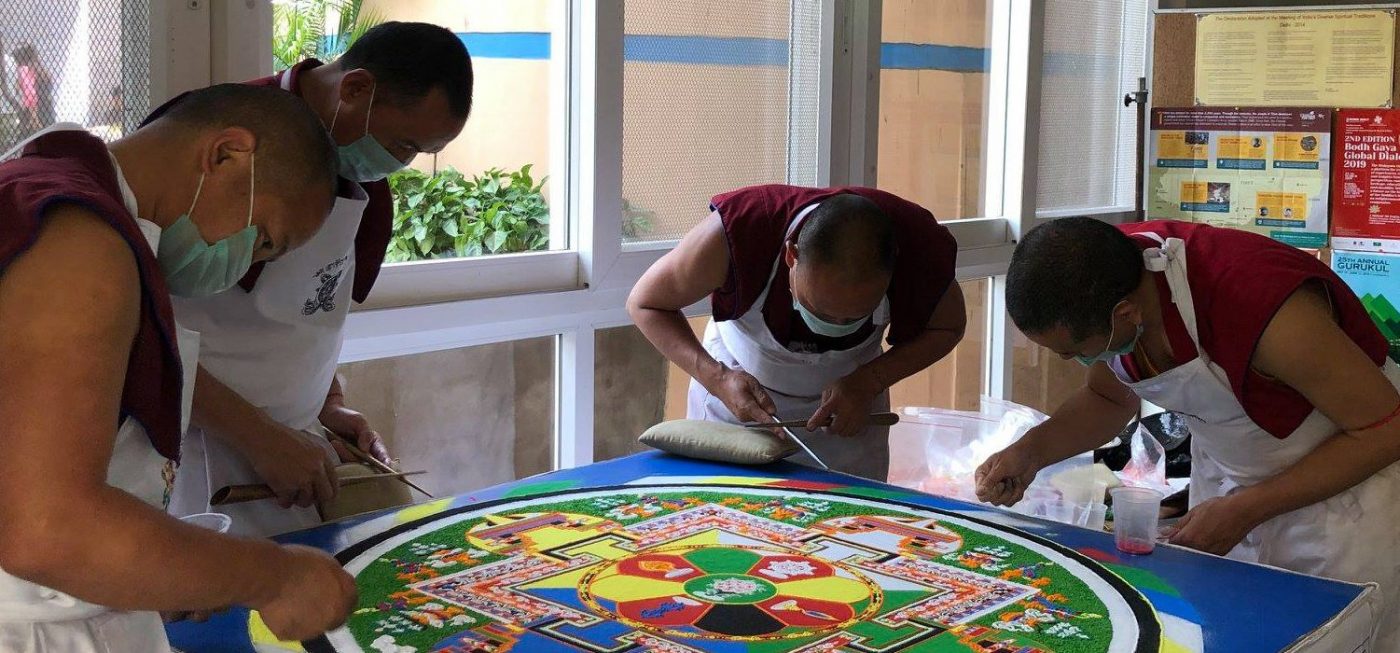
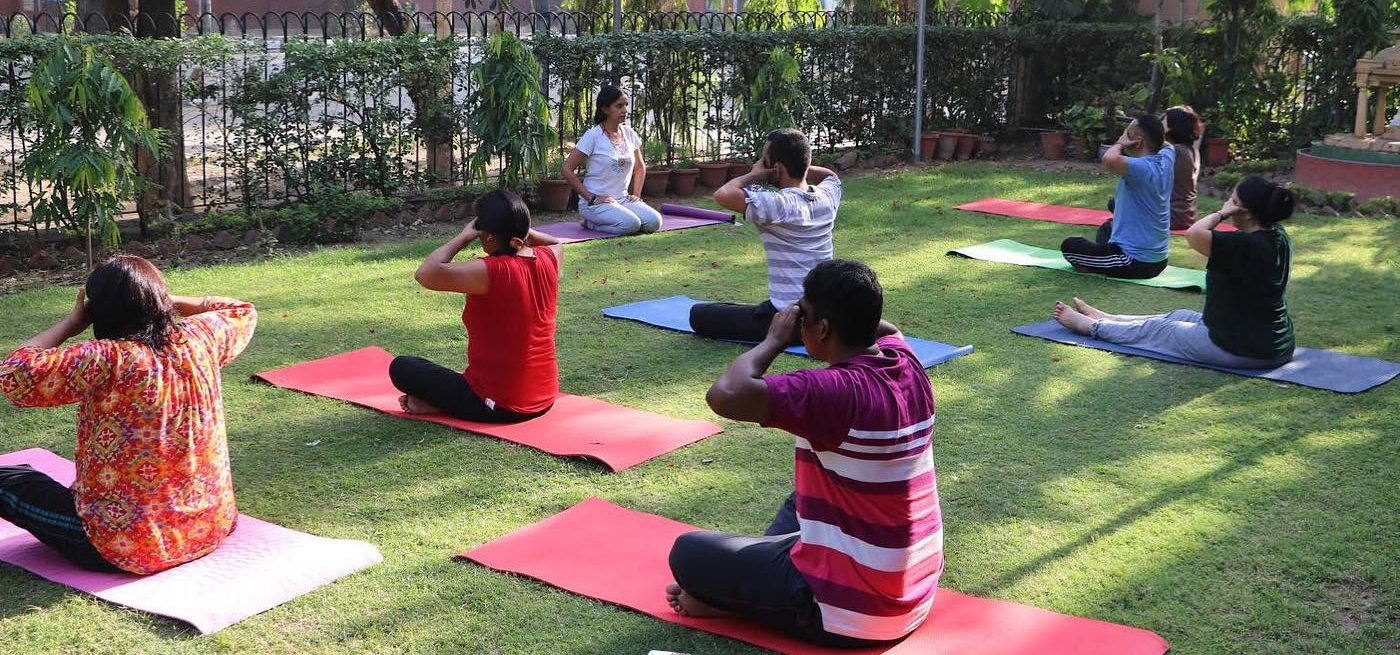
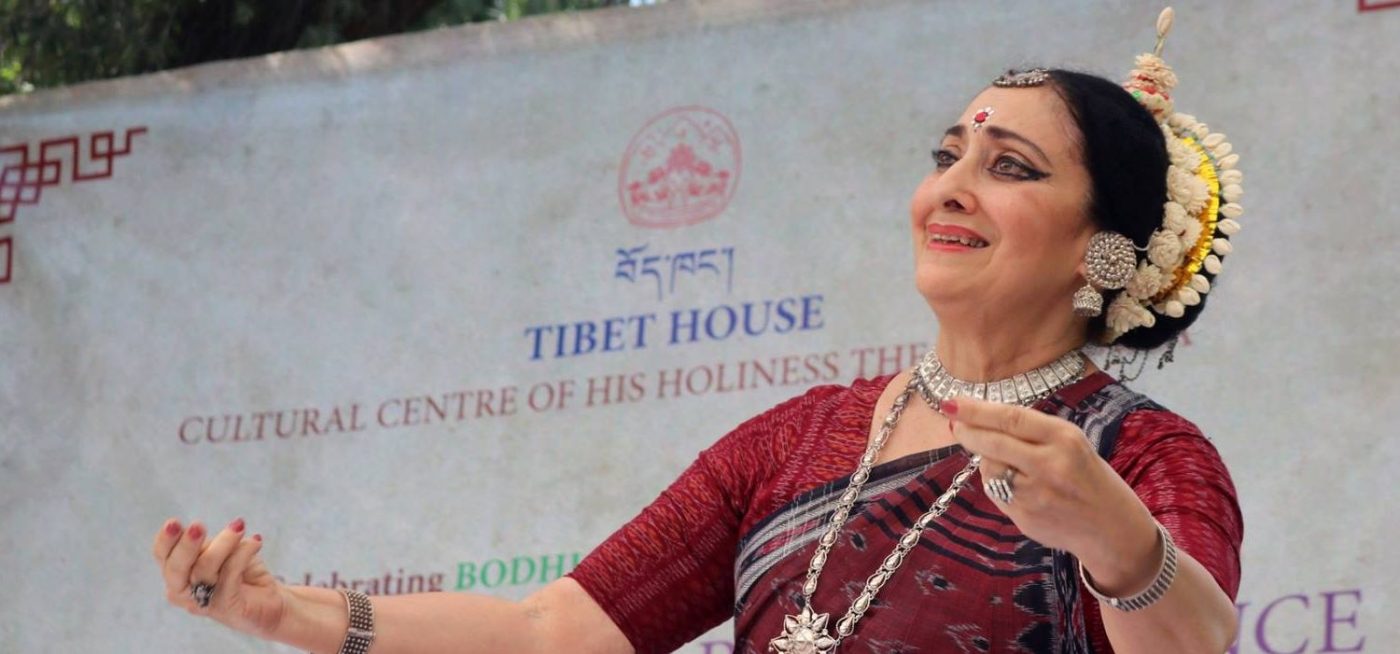
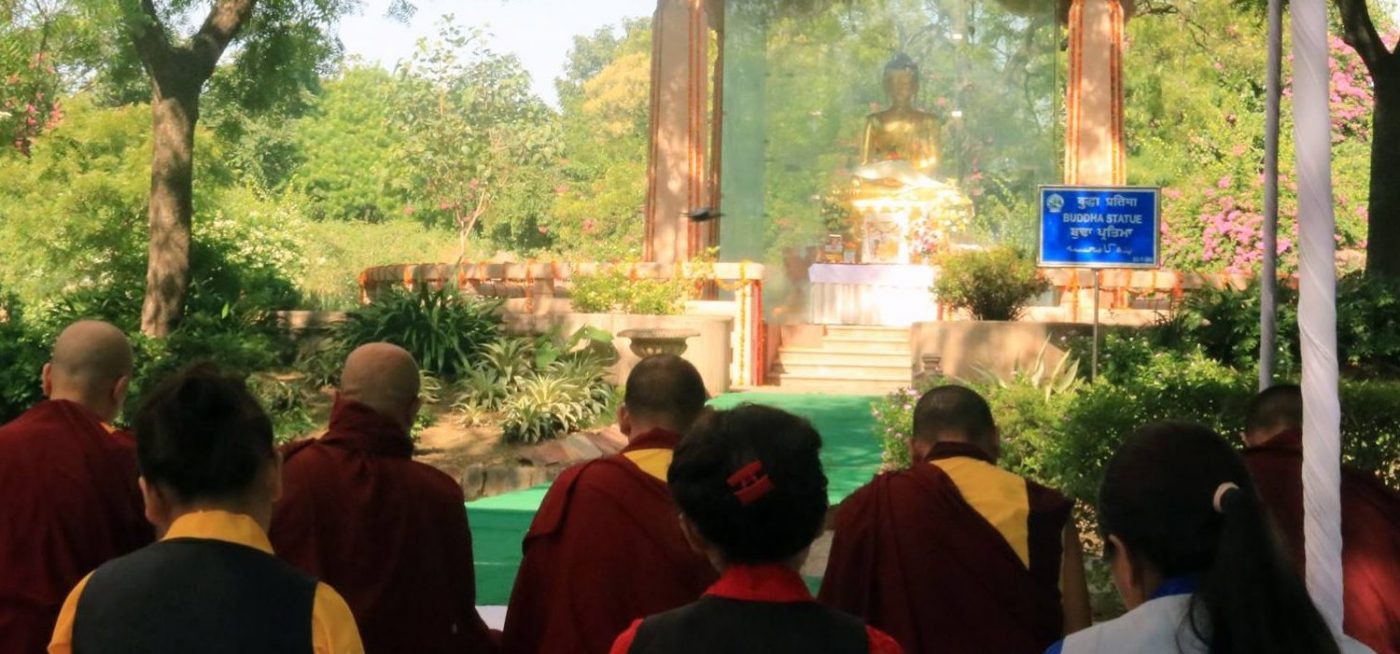
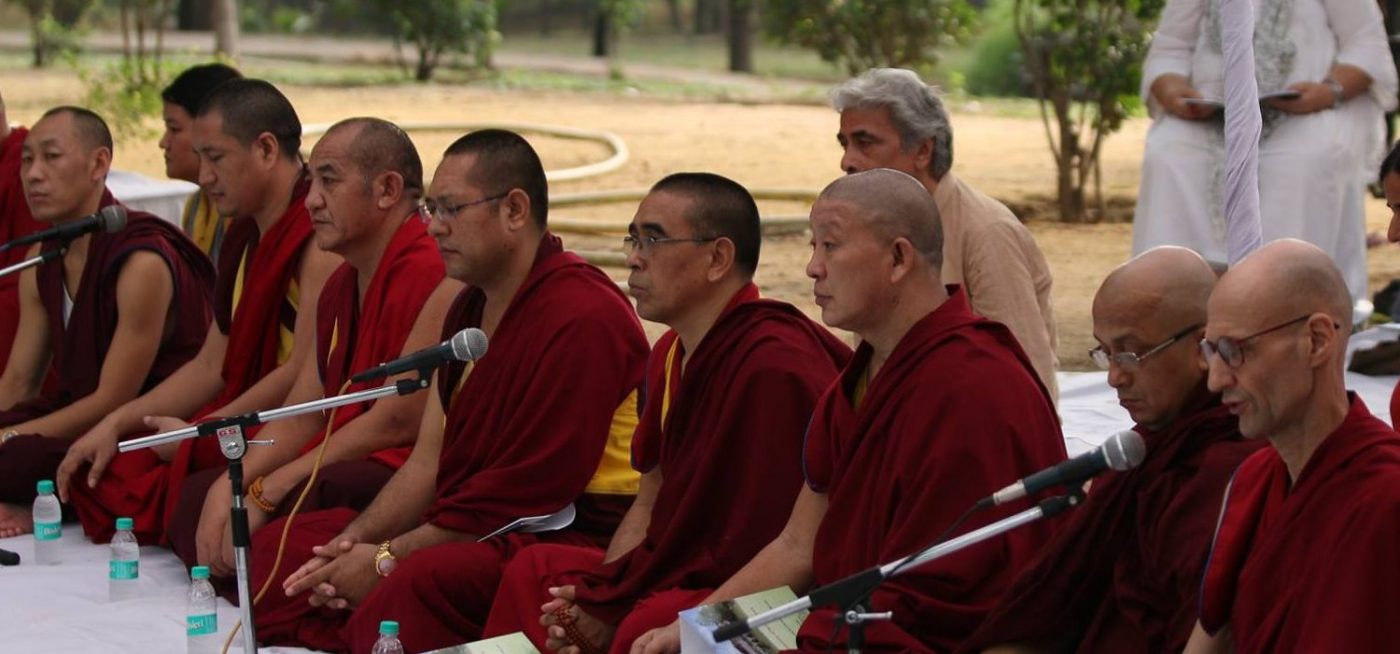






Ceremony of Bodhi Awakening
Since the seventh century AD, Tibetan culture has been deeply rooted in compassionate Buddhist principles inherited from India. His Holiness the Dalai Lama always refers to India as the guru and Tibetans as chela (students). While Tibetan culture is seen in many facets, its uniqueness is in the richness of compassion. The wisdom of interdependency among human beings themselves, between humans and their environment, and humans with other animals underscores this rich universal compassion. H.H. the Dalai Lama values it so much that he gave India the epithet, “The Land of Ahimsa,” for being the source of this treasure.
Tibet House in collaboration with Drepung Loseling Monastery, Take 5 Films Pvt Ltd., India International Centre, and the Himalayan Buddhist Cultural Association hosted the Ceremony of Bodhi Awakening from March 16-18, 2012 celebrating the rich and unique cultural heritage of Tibet and its people. The occasion offered insights into aspects varying from dharma and medicine to folk lore, dance and music. While witnessing each event, one could perceive how dharma is interwoven with every aspect of creativity in Tibetan culture. At a time like this, when greed and avarice are robbing people of their basic human qualities, this ceremony was a nudge to the slumbering society that one can, while carrying out business in samsara, walk the path of dharma with ease and that basic human values need not be divorced from life while doing one’s designated duties.
The Ceremony of Bodhi Awakening rendered a panoramic view of Tibetan culture in a three day event. This joyous tour of the beautiful Tibetan civilisation embodied the rich civilisation of India as well. The various activities of the Ceremony of Bodhi Awakening instilled and enhanced greater wisdom and knowledge in various fields of science and the arts. The stupa in the logo symbolizes bodhi, “perfection,” and the flame atop the stupa symbolizes the action of “awakening.” Just as darkness is dispelled by light, awakening the seed of perfection and goodness takes place through instilling profound compassionate wisdom in beings. Through lighting the lamp of compassion and wisdom, Tibetan culture in all its essence, was manifested during the three days to awaken peace and happiness in individuals and society at large.
More Details on the Ceremony
The Ceremony of Bodhi Awakening exposed the audience to various facets of Tibetan culture. People learned about Tibetan Buddhism and its philosophical implications. The Ceremony gave a platform for dialogue among the experts from four different medical traditions – Ayurveda, Tibetan medicine, Homeopathy, and Allopathy. A Buddhist psychologist engaged in discussion with a Western neuroscientist. Teachings on how to cultivate joyous compassion and the wisdom to see things in the light of interdependency were given to the audience. These dialogues and teachings were presented to inform the audience about the sophistication of a long forgotten tradition in India which the Tibetans inherited from Nalanda University, and now has been revived and cultivated.
The Ceremony began with monks from Drepung Loseling Monastery aesthetically designing a sand Mandala of Arya Avalokiteshwara, the Buddha of Compassion. Seeing the Mandala, the audience sensed the legacy of auspicious peace and compassion in their hearts.
An art exhibition displayed a rich array of historic Tibetan painted scrolls, along with the rare portraits of Tibet before and after 1959. Vijay Kranti’s life long journey of photography on Tibet was inaugurated on the first day of the Ceremony. His pictures of H.H. the Dalai Lama, the Potala Palace and Norbulingka gave the audience a more intimate portrait of H.H. the Dalai Lama from an early age.
Free Tibetan Medical consultation was provided to visitors on all three days. People were amazed to learn how these doctors can detect even the subtlest physical ailments just by placing their fingers upon each wrist and reading one’s pulse.
Sacred Dance and Sacred Music by the Tibetan monks was another attraction of the Ceremony. These rituals have a special healing effect on the environment and the beings living there.
Bodhi Katha performance by some young Indian college students beautifully portrayed a part of the Buddha’s life and His message.
Buddhist meditation sessions in the mornings refreshingly began the day.
On the second day, an evening show about the renowned Tibetan saint Jetsun Milarepa in English, was performed. Not only was it very entertaining, but also richly inspirational for all in the audience to lead a peaceful and compassionately meaningful life.
Presentations on various aspects of Indian and Tibetan classical dance by two expert performers gave the audience a flavor of the subtler nuances of the two traditions.
Tibetan shops displayed Tibetan auspicious colored flags for ones’ luck and the Mentseekhang medical shop made available for visitors souvenirs and remedies from a compassionate culture.
The “Ceremony of Bodhi Awakening” left an impression upon the minds of the audience providing a tour of thousand years old Tibetan civilization in just three days.
Day 1
Exhibitions
The Exhibitions were inaugurated at the venue, Gandhi King Plaza, by the Chief Guest, His Excellency Shri Vir Bhadra Singh, Minister of Micro, Small & Medium Enterprises, at 9:30
am on Day One. Geshe Dorji Damdul, Director of Tibet House, welcomed the Chief Guest with a traditional ceremonial scarf. Before he inaugurated, monks from Loseling Monastery recited the prayers of auspiciousness and Shri Vir Bhadra
Singh proceeded towards the magnificent picture of His Holiness the Dalai Lama and lit the lamp. The exhibition consisted of more than 150 exhibits, that included among others, exhibitions on Tibetan lifestyles during post- and pre-1959, thangka paintings, Vijay Kranti’s photo exhibition of H.H. the Dalai Lama, of deep spiritual experience.
Inaugural Function
The inaugural function was held in the main auditorium of the India International Centre in the morning. After a brief introduction by Ms. Tenzin Pema, Secretary, Tibet House, the portrait of His Holiness was ceremonially brought into the auditorium and was placed on the stage, to the accompaniment of spiritual music played by the monks from Loseling monastery.
The Chief Guest, Professor Shyam Menon, Vice Chancellor of the Ambedkar University, Tsona Rinpoche, Tempa Tsering, Lochen Tulku Rinpoche and other honorable guests lit the lamp and sonorous chants of the monks filled the atmosphere as the lamp was lit. A silent tribute was paid in memory of those Tibetans who had laid down their lives protesting against the Chinese regime.
Welcoming the participants and guests of honour, Ven. Geshe Dorji Damdul, Director of Tibet House, said that the title of the event was changed from festival to ceremony to underline the tragic situation in Tibet and of the monks’ immolation against the atrocities. Referring to H.H. the Dalai Lama as a champion of peace, he said that the Tibetans are being true to the spirit of non – violence as, instead of any retaliation to the injustices meted out to them, they were giving up the most precious thing one cherishes – one’s own life. The title, Ceremony of Bodhi Awakening, reflected the mission of H.H. the Dalai Lama to bring happiness to humanity at large. ‘Bodhi’, he said, connotes perfection while ‘awakening’ expresses blossoming of the Bodhi which is inherently present in everyone. To make the world a big ‘We’ rather than big ‘I’ is the dream of H.H. the Dalai Lama which the Ceremony of Bodhi Awakening aspires to achieve, Geshe Damdul observed.
In his address, Tempa Tsering, representative of H.H. in Delhi, while congratulating the hosts of three day cultural programme, pointed out that while Tibetan culture is an ancient one, what makes it invaluable is that it is living and vibrant even today and has much to offer to the modern world. The culture which, has within its fold philosophy, medicine, music and art, is rich and unique and needs to be preserved in an increasingly interdependent world.
The Chief Guest Dr. Shyam Menon said that this was a historical moment in time that His Holiness lives in India. Great teachers like Buddha and Nagarjuna have once enriched the consciousness and thoughts of this land but it is unfortunate that we have slipped into endemic amnesia. The presence of H.H. is an opportunity to redeem this strand in our civilization, he pointed out. As a teacher he felt the great significance of Bodhi awakening, and said that in today’s milieu of competitiveness and self absorption, it is important to reassert the value of compassion and a good heart. It is the moral responsibility of the teaching community to unfold the hearts and not just the heads of young learners. Time has now come to redefine smartness and success and it is in this context that the title of the event was indeed to be lauded, Dr. Menon said
Tsona Rinpoche in his address also complimented the organizers on the title of the event when he pointed that all of us have the potential to remove our ignorance and as we progress on the path we move towards enlightenment. Which is what Buddha did. We need to awaken and develop the potential in order to take it to an unlimited state.
Speaking on the occasion, Lochen Tulku said that the foundation of Buddhism rests on non-violence and referred to the Four Noble Truths as laws of nature which one can apply in any field of activity.
After the introductory remarks by the guest speakers, a song in praise of H.H. the Dalai Lama wishing him a long life was sung by school children of T.C.V. Day School, Majnuka Tila, Delhi.
Mr. Vijay Kranti, who had held an exhibition of the photographs of H.H. the Dalai Lama, titled Buddha’s Home Coming spoke on how he was planning to have a chain of twelve exhibitions to showcase the different aspects of Tibetan culture in different countries. According to him, the coming of H.H. was like Buddha coming back to the land of his birth and it was only befitting that the inaugural ceremony of his exhibition was part of the Bodhi Awakening Ceremony.
Mr. Ashok Arora and Mr. Gun Bahadur of Tibet House were felicitated for their outstanding service to Tibet House. The inaugural session concluded with singing of Tibetan and Indian National Anthems by school children of T.C.V. Day School, Majnu-ka-Tila, Delhi. The morning session was a perfect start for the Ceremony of Bodhi awakening.
An Evening of Sacred Dance and Sacred Music – Part I
Music and dance are well within the purview of Bodhi awakening, for they actualize the philosophy which the sacred scriptures prescribe. So the evening unfolded with the sound of the sacred dance and music performed by monks from Drepung Loseling Monastery from South India. Dr. Sonal Mansingh, the chief guest, expressed her joy at being part of the evening programmme.
Gala Rinpoche who compered the evening function called it the mystical art of Tibet. The dance, music and multiphonic chants of Tibet resonate the core message of Tibetan spirituality, he added. As the dance and music are spiritual, he urged the audience to focus their minds to understand the nuanced message of Buddha’s teachings and apply them in their lives in order to alleviate the suffering of sentient beings. Costumes, gestures and instruments too have profound meaning which even the performers need to internalize.
Three individual artistic forms reflected three individual elements of this spiritual heritage. First was the overtone chanting whose resonance was deep and profound. This was followed by the dance of the skeleton which symbolizes the ephemeral nature of beings. Then came a spontaneous, intense, and interactive session of monastic debate. Following this, the audience were treated to a visual delight in the form of the Rainbow dance with five colors symbolizing the harmony of the five external elements, five chakras of the body and the five angels. Rinpoche informed the audience that this was the healing dance and was performed when a powerful healing was required.
The concluding performance was an offering for world peace and the motivation was to make the environment more harmonious by bringing this mystic theatre in a secular environment, thus making one aware of the importance of Bodhi awakening.
Opening Ceremony of the Sand Mandala of Avalokiteshvara
The main foyer of the IIC witnessed an atmosphere of sacredness with the resonance of chanting of the mantras by the monks. The creation of a sand mandala of Avalokiteshvarabegan with an opening ceremony. To the accompaniment of musical instruments and through their chants monks consecrated the site, calling forth the forces of goodness. The artist monks began drawing the architectural lines of the mandala of Lord Avalokiteshvara who symbolizes compassion as a central focus of the spiritual experience Mandala, a Sanskrit word, connotes a circle or cosmic diagram depicting the cosmos in harmony. Having originated in India, it found its way into the spiritual tradition of Tibet with the establishment of Buddha Dharma there and since then has become an inseparable aspect of the sacred art of Tibet.
Made of coloured sand particles, the mandala is a visual depiction of the residence of the deity in worship. It is a vehicle to generate compassion and is a tool to realize the impermanence of the phenomenon. It requires rigorous practice in contemplation, and a thorough knowledge of the textual tradition of Buddhism to create a mandala. One can trace the origin of the sand Mandala of Avalokiteshvara to the tantric teachings of Buddha Shakyamuni. The enthusiasm with which everyone sought a glimpse of the Mandala was evident, for it is believed that looking at the mandala alone can create a positive impression on the mind-stream of the observer – The mind stream that will take us on the path of Bodhi awakening.
Altruism, the Fabric of Mahayana Teaching, and the Wisdom of Dependent Origination – The Path travelled by all the Buddhas – A Lecture
In the process of Bodhi awakening, understanding altruism and the wisdom of dependent origination are very crucial. The session under consideration very meaningfully dealt with these concepts. With Mr. Madan Verma, President of Interfaith Foundation as Chair, the two distinguished speakers were Gala Rinpoche and Geshe Dorji Damdul.
Introducing himself as a simple Buddhist monk, Gala Rinpoche said that altruism can be understood in many different ways. He added that the concept of altruism was not confined to Buddha Dharma alone but is a universal principle to follow. Quoting from various poets, authors and different religious traditions, he mentioned that all major religions talk about altruism and compassion. Altruism epitomizes all the qualities of the Buddha and generates happiness. Although it is inherent in the nature of all beings, in order to put it into practice, mind training is very important. One has to familiarize oneself with good qualities, be contemplative, and then actualize it by making the mind familiar to the concept. This is no easy task and takes eons. Rinpoche hoped that we recognize the importance and practice of this precept.
Giving a gist of the Wisdom of Dependent Origination, Geshe Dorji Damdul said that most of our actions are driven by our mind which looks for adequate information for taking a decision. He wondered as to the truth of ‘information’, as information travels to the mind through the medium of perception. The challenging question before us is whether our perception tallies with reality or is merely one’s own mental fabrication. Therefore, the Buddha described that all phenomena are dream-like and are merely mental creations. If this is understood then one’s fear of samsara is removed and suffering can be brought to an end by an understanding that all things are mental constructs. Our problems have a genesis in the misconception of reality as having an independent existence. The moment the light of wisdom dawns on us that all objects depend on mental imputation rather than from objects’ side then the darkness of ignorance is removed and one has ended one’s own suffering. The light of bodhi shines through.
Day 2
Meditation: A Tool for Conscious Living with Practice – Part I
Awakening or blossoming not only takes time but certain disciplines lie within its fold to put them into practice. Meditation is one such tool whose relevance was encapsulated very systematically by Ven. Mindroling Jetsun Khandro Rinpoche. Day Two commenced with a talk by the Chair, Prof. Meenakshi Thapan of Delhi University introducing Jetsun Khandro Rinpoche and talking about the great yogini lineage to which Khandro Rinpoche belonged. She noted that it was a privilege to chair the session.
Thanking the Chair for the introduction and appreciating the title and the contents of the programme, Khandro Rinpoche said that the ceremony of Bodhi awakening has come at a very challenging time. The last few years had been very demanding for Tibet and its people and opportunities like these are the healing oases for the suffering hearts, she added.
She observed that inspite of living at a time when economic development and consumerism have become overriding factors, there still is a deeper wish for introspection and understanding. It is in this context that we need to understand the meaning of meditation or contemplative practices. In today’s world there is a tendency to resort to meditation as an extracurricular activity and to engage in it without even knowing its dynamics. The result is that the mind starts resisting it. The definition of meditation is simply a balanced continuum, a continuum of awareness that one would generate in one’s own self and safeguard that continuum of awareness with absolute integrity and total uncompromising honesty.
Rinpoche opined that people’s interpretations of what meditation actually is vary. But prior to actually engaging in any kind of formal meditation, wemust learn about cultivating observance in our life. So, rather than using the word mediation in the beginning, it is better to call it watchfulness or observance, because that is what awakens the wisdom within our own selves. When the meditation is really made experiential and a foundation of watchfulness is built in one’s own life, then one inherently experiences karma, cause and effect. Being able to see the immediacy of all that we are experiencing at the moment can eventually bring ethics in one’s own awareness, and this sense of mindfulness will create a better situation for oneself and others and generate compassion. For this, one does not have to become a monk, a nun or a Buddhist for that matter, she added.
Giving out a word of caution, she said that while one is in a conducive atmosphere, it is easy to feel good but the benefit of meditation is perceived better when we take it out of the room away from the meditation cushion. True mediation begins in post meditation practices. When one lives with awareness or follows conscious living one learns to be mindful of one’s own body, thoughts, feelings, mind, phenomena and the environment. It is only this mindfulness when developed with all sincerity can put us on the path of bodhi awakening.
Medical Systems: Tibetan Medicine, Ayurveda, Homoeopathy and Allopathy – A Panel Discussion
Buddha Dharma considers human life to be precious. It is with great difficulty that one gets to be born a human being. Because humans have the power of discrimination, one can make use of this life to not only better oneself but also help other sentient beings to do so and alleviate their sufferings. For this, the human body must be kept in proper health for it is only a healthy body that can have a healthy mind. So in the journey of Bodhi awakening, the next milestone was to understand the way different medical systems help individuals to safeguard the body and thereby contribute to in developing a good mind.
Welcoming the organizers and panelists, Dr. Pema Dorjee suggested that along with practitioners of different medical systems who were present, the Chinese and Unani medical system should also be introduced as they could contribute a great deal to the wisdom related to the well-being of the individuals and society at large. Given the constraint of time Dr. Pema Dorjee invited the distinguished medical practitioners to introduce their medical systems in a succinct manner and define good health.
Dr. Kalsang, Tibetan medicine practitioner, explained that Tibetan medicine is termed as Sowa-Rigpa which means to cure the disease, and to sustain a healthy body and mind. This science is based on the principles of five elements. Good health in Sowa Rigpaimplies that the five elements are in equilibrium.
Dr. Ashwini Chopra representing modern medicine stated that basic allopathy works on a very straightforward principle that there is a single cause for a disease. A person becomes sick when he or she gets attacked by an external agent like bacteria. Dr. Chopra admitted that he was deeply aware of the limitations of modern medicine which focuses merely on the physical aspect of the body and said that the time had come when it must integrate with the other medical systems. Modern medicine has no proper definition of good health, except absence of certain symptoms that define a healthy body. But he summarized it as the dynamic equilibrium of forces within and outside.
Dr. Mohammad Qasim, a homeopath, stated this system works on the principle that likes need to be treated with likes. The causes that can cause disease can also cure the disease. In this system the integration of body, mind and soul is recognized. As the human body is part of nature and the external nature has its impact on the wellness of a being, good health according to homeopathy was an equilibrium between soul, body and mind.
Dr. Bhagawan Dash the great ayurvedacharya, while drawing attention to the holistic aspect of the system added that Tibetan medicine is a treasure house and without developing it, ayurveda would remain poor. Ayurveda recognizes the five vital sheaths or koshas of the body and how nourishing of each of them is essential. According to him the purpose of ayurveda is not just curing the disease but that it is a spiritual practice which is directed not only at the health of an individual but also the society at large. Ayurveda defines good health, aarogya, as a state when the three factors or doshas are in equilibrium. In Tibetan medicine, the definition of health means to sustain healthy body and mind. Hatred, anger and illusion are directly related to the state of mind. He emphasized at the importance of keeping the balance the five elements
Dr. Raj Kotwal, a specialist in gastroenterology said that the definition of good health is a state of complete physical, mental, and social well-being.
Dr. Pema Dorjee expressed the wish that a healthy body and healthy mind depend on a balance and that it is very important to know what equilibrium really is. Unhealthy life style and diet must be paid attention to. Questions about depression its symptoms and causes were also discussed.
Indo–Tibetan Relations Before and After 1959 – A Presentation
Buddha Dharma blossomed and flourished in India and travelled in many directions. But it was only in Tibet that the teachings of Buddha not just flourished but developed to an extent that it created a strong bond between India and Tibet. What India lost was very carefully preserved and developed in Tibet. With the coming of H.H. the Dalai Lama to India, Buddha Dharma returned to the land from where in pursuit of Bodhi awakening, the gentle chants of Buddham Saranam Gacchami resonated.
The chair Dr. Honey Oberoi, a psychologist in Ambedkar University, began by saying that the topic for the discussion was extremely important and it was regrettable that not much has been spoken about the about India Tibet relationship, which is a unique one.
Speaker Shri Naresh Mathur, a long time Buddhist practitioner and a lawyer, sketched a vivid picture of the historical relationship between India and Tibet before 1959. According to him the huge Himalayan range and the plateau is the axis where the uninterrupted lineage of Nalanda and the Vajrayana has been preserved and kept alive even today. This relationship, he said, transcended the mundane and is the basis of something that we will be looking for in future. With masters like Shantarakshita, Guru Padmasambhava and Atisha coming to Tibet, the highest philosophical transmission occurred between India and Tibet from the 8th to the 13th century A.D. One sees an extraordinary diligence and application by the Tibetan masters who spared no efforts in making the translations of the Buddhist texts from Sanskrit near perfect. The learned speaker pointed out that the relationship between India and Tibet is a very special one. With His Holiness the Dalai Lama coming to India in 1959 and bringing back the rich Buddhist teachings, India has once again got this wonderful opportunity to get back what she had lost.
Taking on from where the earlier speaker had left off, Mr. Vijay Kranti said that when H.H. along with Tibetans arrived in India fifty three years back in 1959, the relationship between India and Tibet had already taken a definite shape. In 1959 Jawaharlal Nehru realized the challenges and responsibilities H.H. the Dalai Lama was carrying on his young shoulders and encouraged him to focus on education, something that proved to be a turning point in the history of Tibet. The Dalai Lama identified the talents amongst his people and the process of reconstruction started. Today the young Tibetans have arrived at a stage when they are managing things beautifully. They have handled the relationship for the last fifty three years in the most constructive manner as can be witnessed in education, and as rehabilitated in religious learning, arts and crafts of Tibet. Over the period Tibetans not only have a proper government but they have a democratic set up where H.H. has given all his powers to an elected representative. Mr. Kranti said that the presence of H.H. in India has only strengthened the historical bond between India and Tibet.
Concluding the session, the Chair observed that there is a silent gap between young Indians and Tibetans and a dialogue is necessary to bridge the same.
An evening of Sacred Dance and Sacred Music – Part II
Performers: Monks from Drepung Loseling Monastery
The story of prince Siddhartha becoming the Buddha repeatedly reminds us of the Buddha nature in all sentient beings and the need to let that bodhi blossom. One can imbibe a lesson from every event in his life.
As the evening approached, the audience got an opportunity to see two scenes from Bodhi Katha, a dance drama based on the twelve deeds of the life of the Buddha that were enacted by the talented children of Manzil, an NGO under the guidance of the Director Kajoli Khanna. The intention of the play was to remind us of the moral values that must prevail in the society. The first scene depicted Yashodhara and prince Siddhartha’s mental turbulence where Siddhartha declares that he must shun the throne and must leave the beautiful princess Yashodhara. She, on the other hand, hopes that the imminent separation will not happen.
The second scene depicted Siddhartha’s search for the guru. His long quest took him to many teachers and many practices but subjecting the body to pain did not lead him anywhere till he realized that middle path was the way to attain liberation.
The second part of the programme was the Sacred Dance performed by the monks. Gala Rinpoche in his introduction, said that the motivation of the audience was important and requested the members of the audience to connect their minds with those of the performers. The dances are not meant for entertainment but have a meditative quality. Years of intense training and practice are required before the artist can perform them. According to Ven. Rinpoche, these dances have a transformative power of removing obstacles bringing in harmony. The mudras, colours and the instruments used in these dances are highly symbolic and the sacred songs are deeply spiritual with a transformative power.
The audience also got a glimpse of the monastic debate which is an integral part of the training of the monks Explaining the philosophy and the rigors of debates Geshe Dorji Damdul explained that it is a powerful way to expand the mind, increase analytical and sharp mental capacity and finally get at the truth. With questions and counter questions posed to the defender one finally arrives at the truth. The lively debate conducted by the monks evoked great appreciation from the audience
Before wrapping up, Gala Rinpoche thanked the audience and reminded them of the urgency to preserve this unique culture and urged them to keep Tibet in their thoughts and prayers.
Day 3
Meditation: A Tool for Conscious Living with Practice – Part II
Buddhist philosophy shows us the way that leads to an understanding of our inner nature. The wisdom or bodhi is awakened with contemplative practices which serve as tools. The morning unfolded with Khandro Rinpoche’s talk, which was in continuation from the previous day. Deeming it as an honour, the Chair, Ms. Ashum Gupta former Head of Department of Psychology, Delhi University introduced the speaker.
Continuing with the topic of meditation, Khandro Rinpoche said that from a Buddhist perspective, conscious living is not so much living with prayers or a certain idealistic understanding of a dharma practitioner. Conscious living very often in our world gives an emphasis on believing that our minds have to be one with God, or for a Buddhist with the Buddha. But a Buddhist summation of conscious awareness or conscious living is to watch the mind, making it understand that as human beings, we have the potential and the capacity of living an entire day without inflicting or causing harm to others. Buddha Dhrama teaches us not only to refrain from destructive attitude or conduct but also tells us that we have the power to always engage in those activities that we aspire for.
Genuine meditation and an honest continuum of awareness must be integrated in all our moments of living. This, then, is to be applied to our habitual behavioural pattern. The preoccupation of a good Buddhist meditator is that he or she aspires for pure and long lasting happiness for all sentient beings. But unfortunately while that is the aspiration, our conduct is devoid of this. If we watch our actions like a theatrical without being judgmental, we can inevitably see the hypocrisy therein. When that acute observation happens, we find that combined with blessings, teachings and the different practices that we do, we develop a much better understanding of the teachings. It is at this point that we develop devotion which will not prove to be a burden. One of the things that the meditator begins to see and realize is the real nature of mind as the actual basis of all experiences, Rinpoche said. Methods and techniques, mantras and visualizations are important but if there is no pervasive awareness then all these things are inconsequential.
Classical Dances: Tibetan and Indian – A Presentation
The forms differ, formats vary, but the core of the inherent philosophy in the classical tradition of India and Tibet has much in common. This is true even in art forms like classical dance where the dancer’s attempt is to achieve oneness, not only with oneself but also communicate the same to the audience. The Chair Ms. Raji Ramanan, responding to the title of the programme, said Classical Dance of both tradition was not for entertainment but was meant for generating one-pointed-ness, to realize truth.
Well known Odissi exponent Sharon Lowen, through her slide presentation, explained that while superficially both traditions look disconnected, when one looks at the classical tradition of Nalanda, one is able to see parallels from the spiritual and ritualistic perspectives. Both have their genesis in the shastric tradition. According to Ms. Lowen, dance is a way of communication and a language which can teach more than what one would gather from the texts. In the Indian classical tradition, through the images and metaphors, one reaches the ultimate reality which is the core of the Hindu philosophy. The intention of Indian classical dance was to create the spiritual dimension. The important thing is to create the peak of the divine which takes one away from the ego. This is also reflected during the preparatory of performance time when artists maintain a meditative mode. All the movements have a metaphysical meaning dance is the perfect yoga, for it also includes pranayama and the asanas.
The second speaker Mr. Dawa Tashiused many slides to elucidate the vastness of Tibetan classical dance. Tibetan classical tradition has three components – music, dance and opera. Music too varies from the folk tradition to opera, spanning activities from a simple nomadic life to deep philosophical insights. There are dances for every occasion which are performed with various instruments. Bamboo flute, lute and the fiddle are used for classical music and most of the artists are Muslims, he said. The speaker talked about special dances which are performed during specific occasions. An interesting slide presentation of musical instruments was presented before the audience.
Jetsun Milarepa, The Tibetan Saint – A Play
Artists from Gangjong Doeghar, Kalimpong presented a Play based on the extraordinary life of Milarepa. Introducing the story of the great sage Milarepa, Geshe Dorji Damdul explained how incidents in the life of Milarepa led him in search of a teacher. His search took him to Marpa Lotsawa through whose grace Milarepa became a great master. He composed many spiritual songs replete with Buddhist teachings. One such popular song that was enacted for the evening was ‘The Deer and the Hunter’ which carried the message of Buddha in a simple way.
One day the great sage while sitting in meditation in his cave saw a frightened deer chased by a ravenous hound. Filled with great love and compassion for the poor creatures, Milarepa made both of them lie down on either side and preached to them. The hunter who was fierce and full of pride arrived and seeing both his targets sitting peacefully by the side of Milarepa, was further enraged. His attempt to kill the saint failed and in turn he was greatly pacified by the comforting words of the sage and became his disciple.
Dismantling the Sand Mandala: A Symbol of Impermanence
With bodhi awakening and unveiling of the layers of ignorance, one faces the impermanence with a mind that has no grasping. Conditioned phenomena change, beauty fades. As the bodhi awakening ceremony moved to its last lap and the mandala was completed, it was also time to dismantle it, symbolizing the impermanence of all conditioned things. In his closing remarks, Gala Rinpoche said that the preceding three days were spent in creating a magnificent and powerful mandala. He informed the audience that traditionally mandalas were created to invoke a specific deity and to assist the meditator who gets initiated into meditation on that deity. Although the mandala created in the foyer was not done for any visualization purpose, the monks had observed all guidelines and aspects of the tradition while creating the mandala. It was consecrated with traditional chants and the monks maintained meditative mindfulness throughout the making of it, he added. Rinpoche informed that in the creation of the mandala two ceremonies were crucial. One was the opening ceremony, and the other, the closing ceremony. The closing ceremony is regarded as profound and significant, for it reminds us of our own impermanence. In the normal pattern of thinking one does not think of one’s own death. In Buddhist teachings the state of death is the most crucial, bringing us face to face with the reality of emptiness.
Amidst the chants, the colored sand was swept up in a ceremonial manner and was distributed to people who had gathered in great numbers to experience this extremely intense spiritual phenomenon. A pregnant silence had enveloped the atmosphere. The closing ceremony indeed showed that all compounded things were impermanent and they lacked inherent existence, a philosophy that the Ceremony of Bodhi Awakening had envisaged.
Brain in Neuroscience and the Buddhist Concept of Mind – A Panel Discussion
At a time when Science has advanced enough to offer its theories about mind and brain, one feels a need to revisit the theories put forth by the Indian classical philosophical traditions about the same. Though a very short session, the views put forth by the two speakers made one realize the relevance of the topic and the importance of understanding the role of the mind in our existence.
The Chair, Ms. Ashum Gupta, Professor of Psychology at Delhi University, welcomed Dr. P.N. Ravindra Nagendra who has done special application on mindfulness practice with sleep and sleep disorders. The Chair also observed that it is very important to integrate the two topics–Brain in Neuroscience and Buddhist Concept of Mind.
Dr. Ravindra shared how brain science is evolving and is looking at the understanding of wisdom with different philosophical systems, especially those with mindfulness practices. As far as the mind is concerned, Neuroscience defines the mind in the frame work of how neurons in the brain interact with each other and the resultant output is referred to as different attributes of mind. By attributes one means cognition, emotions, and feelings. But in the philosophical system, mind is a phenomenon and not an attribute, he added. Mind as a phenomenon is very difficult to define. But with the evolving imaging technology, it has become possible to evaluate the brain in real time in human beings. Most of the neuroscience study is about statistical behavior and not about causality, he said. We have different levels of consciousness or behavioral states. The emerging evidences have clearly shown that one notices structural changes in the brain when thoughts and emotions are evolved through the contemplative practices. An individual’s way of thinking directly impacts the brain dynamics. Experiments have shown that motivation for achievement is a crucial factor. Dr. Ravindra hoped that in this context Neuroscience and Buddhist philosophy can come together and by understanding how the
contemplative practices affect the brain, the scientists can understand the functioning of the brain better.
The second speaker Geshe Dorji Damdul, while talking about out the mind in Indian classical philosophical tradition, stated that the study of mind becomes very important in the classical Indian traditions like Hinduism, Buddhism, Jainism etc. The fact is that we aspire for happiness and shun suffering. In order to achieve happiness we engage in activities which are determined by thoughts. Undeniably there is an agent which determines our actions. The whole Indian classical philosophical tradition and discussion about karma, rebirth and nirvana make sense only when we understand that brain might come to an end but the mind continues to the next life. Geshe Dorji Damdul while putting forth many points agreed that the way mind functions are still a mystery. Research is on and there is a need to delve deep into the subject.
Valedictory Function
The function concluded with the Director thanking all the volunteers and all the individuals and institutions who collaborated for this event. He was hopeful that one was going back with the seed of bodhi awakening. The ceremony concluded with chants for the long life of His Holiness the Dalai Lama.
On all three days, the lovely setting of Gandhi King Plaza with its glorious trees, proved to be a magical venue for exhibitions. The prayer flags swaying gently with the breeze and the warm sunrays warming the spirits of the onlookers transformed the place and transported one to a different time and space. Alongside the enriching sessions, one had an opportunity to see exhibitions of Tibetan lifestyles during the post and pre 1959 period. The Thangka painting Exhibition, Vijay Kranti’s Photo Exhibition of H.H. the Dalai Lama, and the paintings of Elizabeth Brunner, were a spiritual experience in themselves.
Demonstration of traditional Tibetan carpet weaving took one back in time when tucked within the snow clad mountains, in the land of Tibet, the nomads’ skilful hands wove painstakingly beautiful colorful patterns while their lips hummed a folk song. One got lost in the warp and woof of the weaving crafts person. It was an experience to see the traditional Tibetan thangka painter engrossed in this sacred art.
Demonstration of sand mandala creation provided an experience of absolute resolute and one pointed awareness. Trying to copy what the monks were doing proved to be not just enjoyable but brought in an awareness as to what it takes to create the mandala in which one invokes the deities and then to undo the whole pattern with a sense of detachment keeping the thought of impermanence in mind.
While one’s mind and heart got engrossed in these beautiful experiences, care was taken not to overlook the physical state of ones being. After all, a human body is a precious and rare gift and hence need to be taken care of. Keeping to the spirit of ceremony free medical consultation was provided by eminent physicians from the Tibetan medical tradition.
The ceremony would not have been complete without the traditional tea and snacks which was very thoughtfully provided in different stalls. Books, T-Shirts, CDs and Candles and Tibetan jewelry were also on display and were on sale. The ceremony of bodhi awakening most certainly brought one closer to the distinctiveness of the Tibetan culture. It also brought one nearer to the elderly who, with the rosary moving between their feeble fingers, had dreams of returning to their land.

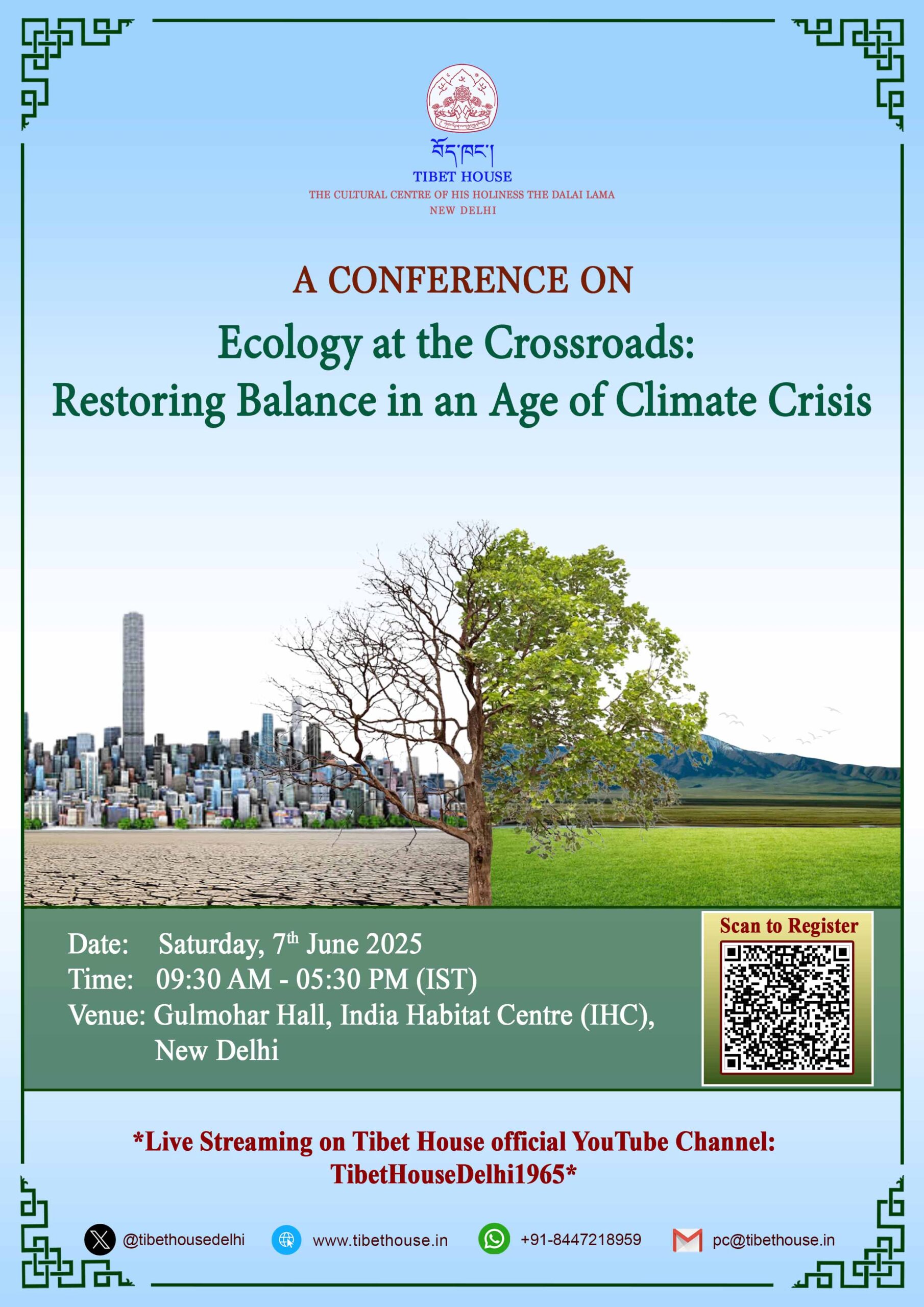
 Date: Saturday, 7th June 2025
Date: Saturday, 7th June 2025 Time: 9:30 AM – 5:30 PM
Time: 9:30 AM – 5:30 PM Venue: Gulmohar Hall, India Habitat Centre, New Delhi
Venue: Gulmohar Hall, India Habitat Centre, New Delhi
